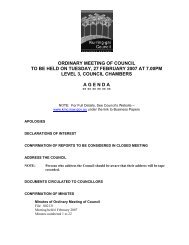Pymble Business Park - Ku-ring-gai Council
Pymble Business Park - Ku-ring-gai Council
Pymble Business Park - Ku-ring-gai Council
You also want an ePaper? Increase the reach of your titles
YUMPU automatically turns print PDFs into web optimized ePapers that Google loves.
12.1 GENERAL<br />
12<br />
Objectives<br />
Controls<br />
1 To maintain natural<br />
waterways and floodplain<br />
processes.<br />
2 To protect natural<br />
features, functions and<br />
biodiversity within riparian<br />
land (including the<br />
waterway).<br />
3 To manage edge effects<br />
appropriately at the<br />
riparian land/urban<br />
interface.<br />
4 To maintain and enhance<br />
the viability of riparian<br />
vegetation and habitats.<br />
5 To protect and enhance<br />
water quality and<br />
aquatic habitat within<br />
the waterway and<br />
downstream.<br />
6 To improve the<br />
connectivity and continuity<br />
of riparian vegetation and<br />
habitat.<br />
7 To re-instate where<br />
feasible the natural<br />
functions and<br />
characteristics of the core<br />
riparian zone including<br />
reconstruction of existing<br />
piped or channelised<br />
waterways and natural<br />
waterways.<br />
8 To prevent further piping<br />
and channelisation of<br />
watercourses.<br />
9 To integrate human<br />
access to waterways<br />
without compromising<br />
the protection of riparian<br />
processes.<br />
Location<br />
1 Subdivisions and amalgamations must provide for a development<br />
footprint outside the riparian land.<br />
2 Subdivisions (via perimeter roads) must front onto riparian land.<br />
3 The provision of service infrastructure including stormwater and<br />
sewerage within the core riparian zone (CRZ) must be minimised.<br />
4 Despite the provisions of 12.2 of this Part, safety fences are<br />
permitted within the CRZ. Fences must be set back an appropriate<br />
distance from the top of the bank, and be of an open design to<br />
minimise barriers to flora, fauna and water.<br />
5 Encroachments onto riparian land may be permitted. In determining<br />
whether an encroachment is acceptable, the following must be<br />
considered:<br />
i) the location of existing development to be retained within the<br />
riparian land;<br />
ii) the scale of the development;<br />
iii) the minimisation of any encroachment through the siting and<br />
design of the development;<br />
iv) location above the 1% flood level;<br />
v) enhancements proposed as part of the development such as<br />
offset areas;<br />
vi) ecological values.<br />
Access<br />
6 Opportunities for the community or residents to connect with and<br />
explore waterways are to be provided where appropriate.<br />
7 Accessways must not compromise the integrity of riparian land.<br />
Walkways, tracks, cycleways and general access points may be<br />
established in the riparian land, where they are designed and<br />
constructed to ensure minimum impact on the riparian land and they<br />
contribute to the management of edge effects or ongoing riparian<br />
maintenance.<br />
Design<br />
8 Impervious surfaces within the CRZ must be minimised. Where<br />
feasible, reduce the existing building footprint and impermeable<br />
surfaces within riparian zones.<br />
9 The development must be designed to ensure connectivity of<br />
vegetation, hydrological flows and fauna movement to, and within,<br />
the riparian land and waterway.<br />
RIPARIAN LAND CONTROLS<br />
10 Riparian vegetation is to be retained and enhanced.<br />
11 Disturbance of soils within riparian land must be minimised, except<br />
Draft <strong>Ku</strong>-<strong>ring</strong>-<strong>gai</strong> <strong>Pymble</strong> <strong>Business</strong> <strong>Park</strong> Development Control Plan 2012<br />
p 167

















